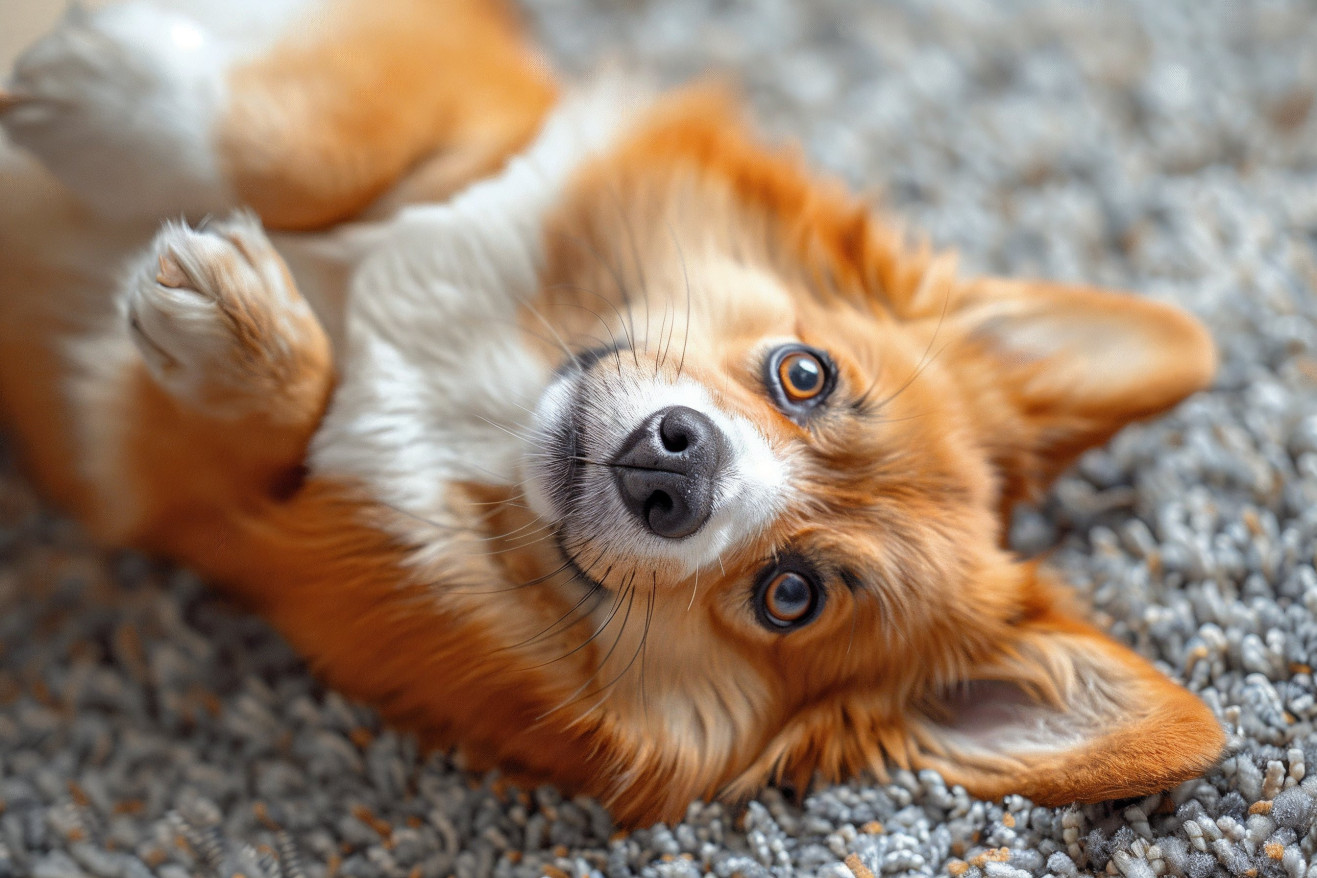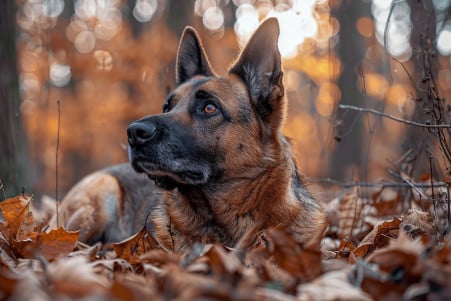Why Do Dogs Roll on Their Backs? The Answers
10 June 2024 • Updated 8 June 2024

Have you ever watched your dog roll around on their back and wondered why they do it? There are a few reasons why dogs roll on their backs: to scratch an itch, to get comfortable, to mark their scent, and to show submission. But it's also an instinctual behavior that dates back to their wolf ancestors.
In this article, we'll explore the biological and evolutionary reasons for this behavior. Drawing on studies by animal behaviorists, we'll look at the deeper reasons that dogs feel the need to roll over and expose their bellies. You'll learn how this strange-seeming behavior helps dogs communicate and interact with their environment and their pack.
Why do dogs roll on their backs?
Why Do Dogs Roll in Smelly Things?
The origins of the back-rolling behavior can be traced back to dogs' ancestors, who likely used it as a hunting strategy. As explained by Psychology Today, rolling in the scent of animal feces or carrion may have helped mask a dog's own smell, enabling it to get closer to potential prey that would otherwise be alerted to the presence of a predator.
It may have also been a way for weaker dogs to avoid detection by stronger predators, as suggested by the American Kennel Club's Dr. Claudine Sievert. "Rolling around in smelly things helps weaker animals keep out of other, stronger predators' sight," she says.
In addition, rolling in a stinky substance may have made dogs more attractive to potential mates. As the Whole Dog Journal points out, researchers at Wolf Park observed that wolves often track a scent to its source after smelling it on a pack member, suggesting that this behavior could signal access to resources and make the dog more attractive.
Although the exact evolutionary explanations are still being debated, it's likely that the back-rolling behavior had an adaptive function for wild canines in their natural habitats, whether it was for hunting, avoiding predators, or attracting mates. As the ancestors of our pet dogs, these primal instincts still exist even if their current purposes aren't always clear.
Back-Rolling as a Form of Communication: What Is Your Dog Trying to Say?
Back-rolling is often used as a signal of submission or to indicate that a dog is not a threat, especially when dogs are meeting other dogs or people. As the American Kennel Club explains, this can be "a friendly posture that invites the other dog to jump in and roughhouse." It's a form of self-handicapping that shows the dog is coming in peace.
In addition to being a sign of submission, back-rolling can also be a way of inviting play or even a way of getting the upper hand in play. A study found that dogs often roll over to invite play or to avoid a play bite to the neck.
When dogs roll in strong scents, they may be trying to communicate with their pack members, letting them know about interesting or valuable items. As Dr. Claudine Sievert from the American Kennel Club points out, this could be a way for "weaker animals [to] keep out of other, stronger predators' sight."
On the other hand, rolling over and exposing the belly can also be a sign of fear, anxiety, or stress in certain situations, indicating that the dog is uncomfortable and asking for space. As mentioned on So Much PETential, a dog that is "stiff with tense muscles and a tense face" is showing that they want space, not necessarily that they want their belly rubbed.
As with other dog behaviors, it's important to look at the context and other body language to understand what a dog is trying to communicate when they roll over. Despite the potential for misinterpretation, back-rolling can be an important form of communication for dogs.
When Rolling on Their Backs Is a Problem: Health Concerns to Look Out For
If your dog is rolling on their back too much, especially if it’s accompanied by other symptoms, it could be a sign of an underlying health issue. According to The Spruce Pets, skin irritations, allergies, external parasites, or dry skin can lead to excessive rolling as dogs try to scratch or relieve themselves. Meanwhile, WagWalking points out that if a dog is licking, scratching, or causing damage to their hair or skin while rolling, it may be a sign of a more serious issue.
While it’s rare, compulsive rolling may be a sign of an obsessive disorder or another behavioral issue that needs to be addressed by a professional, according to the Whole Dog Journal. Pet parents should talk to their vet if they notice any worrisome changes in their dog’s rolling behavior or if their dog seems to be distressed by it.
How Breed and Personality Impact Back-Rolling
While breed can have an impact on certain behaviors, it's important to remember that no breed has a set personality or set of characteristics, as shown in a recent study on the genetics of dog behavior. In fact, the study found that only 9% of the variation in behavior could be attributed to breed and concluded that breed "is generally a poor indicator of individual behavior."
Instead, individual personality and environmental factors are more important in determining a dog's behavior, including their likelihood of engaging in back-rolling. For example, the Harvard Gazette notes that certain breeds with larger amygdalas or premodern brain structures may be more likely to engage in anxiety-related behaviors such as submissive rolling. Meanwhile, a study on personality in dogs found that dogs with higher levels of novelty-seeking and activity were more likely to engage in play behaviors, including rolling on their backs, during social interactions.
A dog's early socialization and handling can also impact their likelihood of back-rolling. As the American Kennel Club points out, the right care and handling during the neonatal period and the right exposure to new experiences can help ensure a dog's healthy development and shape their personality.
Redirecting and Coping With Excessive Back-Rolling
If a dog's back-rolling becomes a problem or happens too often, pet parents can use positive reinforcement training to redirect and cope with the behavior. According to Rover, interrupting the behavior with treats and redirecting the dog's attention to an alternative behavior or surface can work.
Offering alternative surfaces or areas for dogs to roll on, such as turf or designated areas, can help dogs satisfy their natural instincts. As mentioned by The Native Pet, "Offer an alternative surface to roll on, like turf, that can be easily cleaned. This allows your pup to still get that rolling fun in without exposure to allergens or stinky smells."
For more extreme or compulsive cases of back-rolling, it may be necessary to work with a professional dog trainer or behaviorist. That said, as noted by Smart Dog University, it's important to never punish or scold the dog for back-rolling as it can damage the bond between pet and owner and make the behavior worse.
Conclusion: Understanding the Many Reasons Dogs Roll on Their Backs
There are many reasons why dogs roll on their backs, from trying to scratch an itch to trying to attract attention. In most cases, this is a very normal behavior. After all, dogs are just like people in that they sometimes get itches in hard-to-reach places on their backs. A good roll on the ground can feel satisfying and help them hit the perfect spot. "Sometimes [different textures] give them an extra sensation during that itching to help relieve it," says Nicole Ellis, CPDT-KA, a certified professional dog trainer.
Dogs are also known to roll on their backs in new areas to put either their scent on that area or, to get that smelly item from that area onto them to disguise their own scent. One of the most common instances of back rolling may be when your dog meets a new dog. This behavior is often to show other dogs or people that they are not a threat. "That's often [a dog] kind of saying, 'I'm not gonna pounce on you. I'm not gonna do anything.' And by rolling on their back, they're kind of exposing their most vulnerable parts," says Ellis.
When a dog is in a good mood, they may roll on their backs as if to say, "Hi, rub my belly and play with me, please!" According to Ellis, dogs rolling on their back while playing can feel good because the dog can stretch and feel comfortable.
Dogs also roll on their backs to show they come in peace. You might see your dog greet you this way when they are excited to see you. The posture would be accompanied by a loose, squirmy body and an open mouth. However, if a dog is scared or anxious, they may also use that position to diffuse or prevent aggression.
A far simpler explanation for your dog rolling on their back is to scratch an itch. Dogs' paws simply can't reach behind them, so rolling on grass or the carpet is a great way to deal with irritated skin. Dogs may also roll on their backs to help regulate their temperature when they're too hot, exposing their belly to the breeze.
Finally, dogs love to roll in stinky things like dead animal carcasses, and a good back roll is a great way to get covered in the scent. This may be a predatory strategy left over from their wolf ancestors, or they may do it to take the smell back to their pack members.
Appreciating the quirky charm of back-rolling is part of embracing the unique personalities and behaviors that make our furry friends so endearing.


